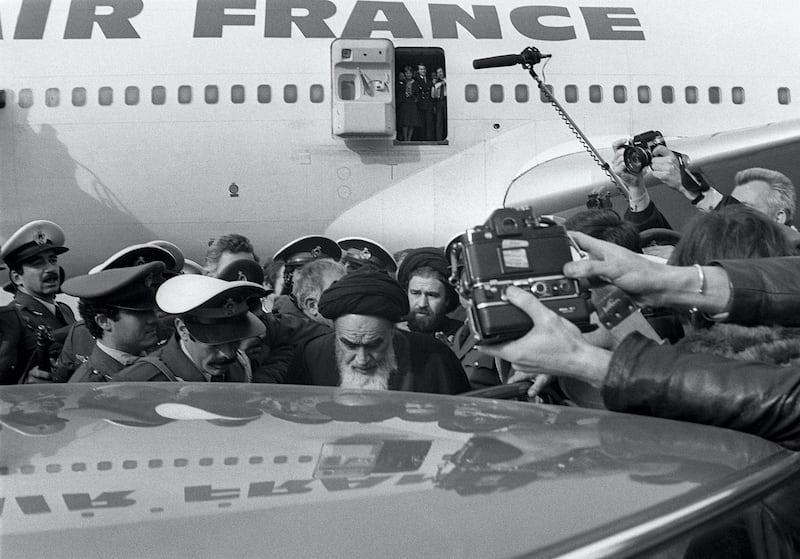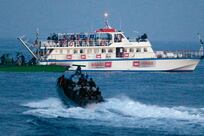When Iranians took to the streets 40 years ago to call for the overthrow of the Shah, their primary motivation was to rid their country of a corrupt and repressive regime.
The final years of the Pahlavi dynasty, which had ruled the country since 1925, had seen the country succumb to widespread corruption and economic mismanagement, while any attempt to protest at the Shah’s many failings was brutally suppressed by the country’s feared Savak intelligence agency.
So when the relatively obscure figure of Ayatollah Ruhollah Khomeini returned to the country from his comfortable exile in Paris, there was widespread rejoicing, as the Shah's rule finally came to an ignoble end on February 11, 1979, with the last of the Pahlavis and his entourage being forced to flee the country.
Khomeini, who had himself sought exile in 1964 in neighbouring Iraq, before eventually relocating to France, owed much of his popularity among Iran’s growing legions of anti-government protesters to his uncompromising stance towards the Shah. While most other opposition leaders campaigned on a platform of reforming the government, whereby the Shah might be allowed to remain in power, Khomeini insisted that the only solution to the country’s woes was the overthrow of the regime.
He built his following in Iran by distributing audio cassettes, recorded in the suburbs of Paris and then smuggled into Iran. He was assisted by a network of clerics, who were opposed to many of the secular reforms the Shah had introduced but Khomeini also relied heavily on other opposition groups, such as the Marxists and nationalists, who wanted to replace the Shah’s rule with another form of secular government rather than the uncompromising Islamic state that Khomeini had in mind.
But such was the desire of most Iranians for change, that many overlooked or outright ignored the small print in Khomeini’s manifesto.
It was only after his triumphant return to Tehran, where his plane was mobbed by crowds of enthusiastic supporters when it touched down at the airport that now bears his name, and the formation of the Islamic republic, that it finally dawned on the Iranian people that the kind of government Khomeini had in mind was very different to the one they had experienced under the Shah.
Almost immediately, revolutionary courts were established and bloody purges instituted against those who opposed Khomeini’s insistence on establishing a regime based on his strict interpretation of Islamic law. It enshrined his role as the velayat-e faqih, “the regency of the theologian”, whereby he would enjoy supreme authority for running the country.
As one of Khomeini’s former pupils, who had studied under him in the Iranian holy city of Qom many years previously, later recalled: “People looked up to Khomeini because of his political opposition to the Shah, not because of his religious teachings. Little did we realise he was looking for a path that would give him so much power.”
In essence, Khomeini and his followers stole the Iranian revolution from the protesters who had campaigned for the overthrow of the Shah and had expected the Shah’s regime to be replaced by another secular administration, as had generally been the case during Iran’s frequent political upheavals during the 20th century, rather than Islamic dictatorship.
The result is that, 40 years on, rather than enjoying the fruits of political liberation, the Iranian people now find themselves the victims of another corrupt and repressive regime, the only difference being that the current administration is run by a gerontocracy of repressive clerics, rather than a vainglorious imperial dynasty, which is how the Shah's regime came to be seen in its latter days.
Certainly, if the aim of the revolution 40 years ago was to improve the country's economic wellbeing, then subsequent events have proved to be a bitter disappointment.
In the past year, Iranians have experienced a precipitous 50 per cent decline in the value of the rial, while inflation is now estimated to be running at an alarming 42 per cent. Half the population is reported to live below the poverty line and the high rate of youth unemployment is one of the main drivers of mounting discontent, which has seen sporadic riots and protests erupt throughout the entire country since late 2017.
Moreover, against this disastrous economic backdrop, the ruling clique of ageing leaders appear completely out-of-touch with the needs of ordinary Iranians.
Only last week, Tehran’s police chief decreed that the relatively inoffensive pastime of dog-walking was “un-Islamic”, while Iran’s chief prosecutor has insisted on maintaining the current high level of punitive amputations, a practice that is deemed barbaric in the rest of the civilised world.
These are precisely the type of conditions which, in normal circumstances, would result in mounting pressure on the regime to mend its ways, or else to step aside and let others try to rectify the country’s economic problems.
But the tragedy of modern-day Iran is that, while many desire radical change, their ability to make any headway is thwarted by the regime’s expertise in political repression, which was amply demonstrated during its brutal suppression of the Green Revolution 10 years ago.
The only way that the Iranians are likely to have any chance of removing the regime will be if the international community unites in pressing for regime change. But with all the major European powers –including Britain, France and Germany – appearing reluctant to join the Trump administration in condemning the regime's decades of misrule, the oppressed Iranian people have little chance of ending their suffering any time soon.
Con Coughlin is the Daily Telegraph’s defence and foreign affairs editor and author of Khomeini’s Ghost





